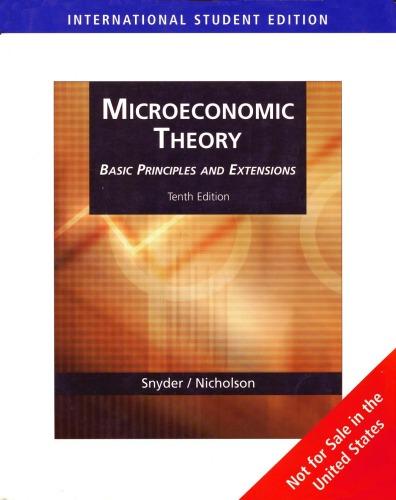15.12 Signaling with entry accommodation This question will explore signaling when entry deterrence is impossible, so the
Question:
15.12 Signaling with entry accommodation This question will explore signaling when entry deterrence is impossible, so the signaling firm accom- modates its rival's entry. Assume deterrence is impossible because the two firms do not pay a sunk cost 18See S. Salop, "Monopolistic Competition with Outside Goods," Bell Journal of Economics (Spring 1979): 141-56.
to enter or remain in the market. The setup of the model will follow Example 15.4, so the calculations there will aid the solution of this problem. In particular, firm i's demand is given by where
a, is product is attribute (say, quality). Production is costless. Firm 1's attribute can be one of two values: either a = 1, in which case we say firm 1 is the low type, or a = 2, in which case we say it is the high type. Assume there is no discounting across periods for simplicity.
a. Compute the Nash equilibrium of the game of complete information in which firm 1 is the high type and firm 2 knows that firm 1 is the high type.
b. Compute the Nash equilibrium of the game in which firm 1 is the low type and firm 2 knows that firm 1 is the low type.
c. Solve for the Bayesian-Nash equilibrium of the game of incomplete information in which firm 1 can be either type with equal probability. Firm 1 knows its type, but firm 2 only knows the probabilities. Since we did not spend time in this chapter on Bayesian games, you may want to consult Chapter 8 (especially Example 8.9).
d. Which of firm 1's types gains from incomplete information? Which type would prefer complete information (and thus would have an incentive to signal its type if possible)? Does firm 2 earn more profit on average under complete information or under incomplete information?
e. Consider a signaling variant of the model that has two periods. Firms 1 and 2 choose prices in the first period, when 2 has incomplete information about 1's type. Firm 2 observes firm 1's price in this period and uses the information to update its beliefs about 1's type. Then firms engage in another period of price competition. Show that there is a separating equilibrium in which each type of firm 1 charges the same prices as computed in part (d). You may assume that, if firm I chooses an out-of-equilibrium price in the first period, then firm 2 believes that firm 1 is the low type with probability 1. Hint: To prove the existence of a separating equilibrium, show that the loss to the low type from trying to pool in the first period exceeds the second-period gain from having convinced firm 2 that it is the high type. Use your answers from parts (a)-
(d) where possible to aid in your solution.
Step by Step Answer:

Microeconomic Theory Basic Principles And Extensions
ISBN: 9780324585377
10th Edition
Authors: Walter Nicholson, Christopher M. Snyder






